
Wine Culture and Information since 2002 - Volume 22
 Wine Culture and Information since 2002 - Volume 22 |
|
Issue 58, December 2007 |
Contents |
|
|
Tradition: Advantage or Obstacle? |
|
Since the times man began making wine, or it should be better to say, since the times man began to commercialize wine, culture and tradition have been connected to this beverage and, most of the times, used as a promotional factor in order to ensure success on sales. In most of the cases, traditional and cultural factors have represented a winning way in the commercialization and identification of a wine. A historical example, among the many, is Bordeaux, which since the times of ancient Romans could “spend” its name everywhere as a synonym of wine - good wine - a fame still alive nowadays. Of course, besides a name, it is also important to have something else, otherwise a name - alone - sooner or later may become a meteor and sink into oblivion of time. Among the factors determining the success of a name, there are also the consequences of the evolution of a product - including wine - which inevitably changes and got adapted to time according to new trends, taste, necessities and cultures. This concept is more evident if we think about the way our ancestors made wine in past times: no one today, let's say, most of the people today, would find pleasing and “drinkable” the wines considered in the past to be excellent nectars. Technology has played an important role, as to allow the improvement of many wines and to make them virtually impeccable, something that, with no doubt, has nothing in common with the tradition of past times. The way with which are produced wines today is undeniably different - even distant - from the methods used fifty years ago. Nevertheless, there are many who still try to identify a wine with tradition, when of that tradition is clearly left a name and a distant memory only. In these times of supertechnological wines, does it make any sense to talk about ancient traditions, when they mainly play a romantic role and used, in most of the cases, to not disturb the conscience of those who don't want to accept the fact things have inevitably changed? Who is making today a wine by exactly using the techniques of fifty or one hundred years ago, that is in the time recalled in celebrating a tradition? Probably no wine producer is doing that, maybe few vintners who make wine for the fun of it and for personal consumption and who - very likely - does not have the resources or the interest in making use of modern technologies, as opposed to what it is common in “commercial” wine. Although this could be seen as a criticism, it is indeed a consideration highlighting what has always accompanied man, in the good and in the bad, during the course of his history: evolution and development. It is therefore normal things undergo processes of evolution and development, derived from a better knowledge - although and however limited - as to allow the progress of intelligence and human expression. Something which already and inevitably happened fifty years ago, when wine was made in a different way from one hundred, two hundred, one thousand years ago. It is very likely in every epoch men recalled the traditions of past times, despite the fact everyone was trying to improve production and not only for commercial purposes only. It is very likely in fifty years there will certainly be someone who will recall tradition - that is what we are and express in this time and era - when technology and progress will have inevitably developed new systems and methods for making wine, something which is always happened in the course of time. Better or worst than what we make today, this is something future generations will tell, but the technological progress will have inevitably introduced new methods, just like the way we have today techniques completely unknown and unthinkable in past times. Result of progress: it always existed, it always accompanied man and it will always exist. Also in the case of wine. Therefore, how much does it make sense to cling to traditions when they undeniably get adapted and evolve with the expression, culture and customs of the time? How many foods, how many wines and customs belonging to past times - therefore undeniably traditional - have disappeared, or better to say, got evolved as time passed by? Probably all of them. There is nothing wrong in recalling and keeping traditions of past times: after all what we are today is also the undeniable result of traditions and of the past, therefore it is good not to forget them, not only to help us to remember where we are from and where we can go from here. What is probably upsetting in the showing off and in the safeguarding of traditions is speculation. Most of the times a tradition is abused only for commercial purposes, in a way to make consumers believe tradition - alone - could be the only factor ensuring quality. And what it is even more upsetting is that no one - or maybe few - make today wine according to a real tradition and to what it really represents, both because some laws and some hygienic issues do not allow the use of some traditional procedures, as well as what was made in past times does not sometimes meet the taste of modern men. Therefore, is tradition an obstacle? Of course not: it is a huge advantage in case we make use of intelligence in order to learn from the experience every tradition can offer and to use it in order to improve something already existing. In this sense it is significative the experience of some wine producing countries belonging to the so called New World, where, undoubtedly, there were no local traditions to be used as a reference. In these places they have simply watched the traditions of others while trying to improve them in order to make quality. The result is evident for everyone and, in particular, with an undeniable technological advantage also for those countries which are still trying to sell tradition while trying to make everyone believe this is, alone, a winning reason. It can certainly be, provided there is also a quality which can justify the price of tradition, not only according to an economical point of view. No one would probably pay for something of doubtful quality, even though it is traditional. Tradition certainly is an advantage, it is an invaluable expression of the evolution of intelligence and culture of human beings and the place where they live in, a heritage to be passed to future generations in order to understand the mistakes of the past while hoping they will not made again. Let's recall, keep and safeguard traditions - it certainly is good and right, this is also true for wine - provided they will not become an unbearable burden and would limit intuition, intelligence, fantasy and the capability of dreaming in men.
|
||||
Comparing Pinot GrisFine grape to which was assigned the task of relaunching in the 1980s the fashion of white wines in Italy, Pinot Gris is still today one of the main protagonists of wine making |
|
In the beginning of the 1980s, in Italy, when a wine was about to be ordered at the restaurant, as well as when it was purchased in other occasions, most of the times was a Pinot Gris, or Pinot Grigio, like Italians call it. To this grape was in fact assigned the task or relaunching and reawaken the fashion of white wines, a phenomenon lasted for many years and which strongly changed the preferences of Italians, who were mainly oriented to red wines. From the North-Eastern areas of Italy, this fashion began to spread everywhere in the country, and also in other regions they started planting Pinot Gris with the explicit goal of taking advantage of the commercial opportunity offered at that time. The golden age of Pinot Gris lasted many years, until in Italy was finally started a wine making revolution with an increasing quantity of quality wines being produced. The availability of these new quality wines, caused a progressive loss of interest for Pinot Gris - as well as white wines in general - although keeping, even today, a large number of supporters. The origins of Pinot Gris are today very clear as it is considered a genetic mutation of Pinot Noir, the famous grape protagonist of the elegant red wines from Burgundy. Pinot Gris can be recognized for the particular color of the skin of its berries, a color varying from blue-gray to bronze-pink, variation which can also be seen in the berries of the same cluster. In fact, it is the skin to characterize the wines produced with Pinot Gris and to offer wine makers two distinct methods of interpreting this grape. Sometimes the must of Pinot Gris is allowed to macerate with the skins, therefore giving the wine its typical coppery color, a technique rarely used today, however giving the wine an interesting aromatic profile as well as a fuller body. Most of dry Pinot Gris is in fact vinified without the maceration of the skins on the must - or with a short maceration of few hours at a low temperature in order not to extract color but only aromas - giving the wine the typical color of whites.
|
|
Pinot Gris is a grape capable of making very interesting wines and with a very elegant and refined aromatic profile. The production technique mainly used today provides for the fermentation and aging in inert containers, most of the cases steel tanks, and very rarely are being used casks and barriques. Pinot Gris is very appreciated and common in Alsace, where it is still today produced by allowing the skins to macerate on the must, therefore giving the wine its typical coppery color. The same technique is still used in Germany, where the grape is known as Rülander, a name sometimes used in the wines produced in South Tirol. In Italy Pinot Gris - here known as Pinot Grigio - is mainly cultivated in Friuli Venezia Giulia and in Trentino Alto Adige, however this grape is also cultivated in Veneto and, marginally, in other regions where it is usually used together with other grapes.
The goal of our comparative tasting is the study of organoleptic qualities of Pinot Gris, by examining three wines produced in Friuli Venezia Giulia, the region in which this grape is very common. The wines which will examine are produced with different vinification techniques, including the fermentation and maceration in wood containers. The first wine of our comparative tasting is Castello di Spessa's Collio Pinot Grigio, completely fermented and aged in steel tanks. Also the second wine is produced in the same area, also in this case fermented and aged in steel tanks for about 8 months: Villa Russiz's Collio Pinot Grigio. The third wine of the comparative tasting is completely different from the previous ones, both in the vinification technique as well as the area of origin: Friuli Isonzo Pinot Grigio Gris of Lis Neris. This is in fact the only wine of the three to be fermented and aged in cask for 10 months. The first two wines will be served at a temperature of 10°C (50°F), whereas for the third wine will be used a temperature of 12°C (54°F). For the tasting we will use, as usual, three ISO glasses.
|
||||||||
|
The aspect of dry wines produced with Pinot Gris depends on the vinification technique, in particular on the choice on macerating the skins on the must or to follow the usual white vinification method. In white vinification technique is sometimes allowed the maceration of skins in the must at low temperature in order to extract aromatic qualities of the grape. The same technique is used with Pinot Gris and, at higher temperatures, allows the extraction of the color from its skins as well. This technique, considered in many areas as traditional, besides enriching the must with aromas, also gives the wine a coppery hue, as the skins of Pinot Gris have a color from blue-gray to pink-bronze. In Italy this technique is sometimes used in South Tirol, whereas is it avoided in all the other Italian areas. The color of Pinot Gris goes from greenish yellow to straw yellow, sometimes showing a golden yellow hue in its youth. Golden yellow is the color characterizing Pinot Gris after few years of aging in bottle, despite it is best to drink these wines during their first years of life. We will begin the phase of the appearance analysis of our comparative tasting from Castello di Spessa's Collio Pinot Grigio. By holding the glass tilted on a white surface, we will evaluate the color of this first wine by observing the base of the glass. It will be observed a pale golden yellow color, whereas observing the edge of the liquid mass, towards the opening of the glass, the nuance will show a straw yellow color. Let's now pass to the evaluation of the second wine - Villa Russiz's Collio Pinot Grigio - made in the same area of the previous wine and aged in steel tanks. This Pinot Gris shows a brilliant greenish yellow color - paler than the previous one - and the same color can be observed in nuances, to the edge of the liquid mass. The third wine of our comparative tasting, Friuli Isonzo Pinot Grigio Gris of Lis Neris, is the only one to be fermented and aged in cask. The color of this wine is pale straw yellow with greenish yellow nuances.
|
|
The aromas of dry wines produced with Pinot Gris belongs to the world of fruits and flowers, always elegant and refined, a characteristic which has always attracted both wine lovers and wine makers. Thanks to these qualities, Pinot Gris is used together with other grapes, giving wines the elegance and finesse of its aromas. Among the main olfactory qualities of Pinot Gris, there are many aromas belonging to fruits, including tropical fruits. Among the main fruit aromas associated to Pinot Gris are found apple, pear, pineapple, peach, plum, lemon, banana, lychee, apricot and grapefruit. In Pinot Gris is also possible to find aromas of dried fruit, in particular almond and hazelnut. The world of flowers of Pinot Gris is pretty rich, in which can be mainly found hawthorn, broom and acacia, sometimes also jasmine and elder. In Pinot Gris can sometimes be perceived mineral aromas as well as vegetal aromas, such as hay and tomato leaf. The olfactory analysis of our comparative tasting will start from Castello di Spessa's Collio Pinot Grigio. By holding the glass in vertical position and without swirling, we will proceed with the first smell, in order to evaluate opening aromas, lighter and therefore capable of volatilizing with small quantities of oxygen. From the glass will emerge intense, clean and pleasing aromas of apple, plum and hawthorn, three aromatic qualities found in many wines produced with Pinot Gris. After having swirled the glass, in order to allow the volatilization of heavier aromatic substances because of the effects of a higher quantity of oxygen, we will proceed with a second smell which will complete the olfactory profile of this second wine. From the glass will be appreciated aromas of pineapple, grapefruit and pear which will be followed by flowery aromas of acacia and broom. A very balanced and clean nose, where the aromas are well perceptible and in good balance. Let's now pass to the evaluation of the second wine - Villa Russiz's Collio Pinot Grigio - produced in the same area of the previous wine. Opening aromas, by holding the glass in vertical position and without swirling, will allow the perception of pear, apple and pineapple: a more tropical nose than the previous wine and, also in this case, pretty typical for this grape. After having swirled the glass, let's now proceed with the second smell which will allow the appreciation of the aromas of banana, lychee, grapefruit and hazelnut, completed by flowery aromas of hawthorn and broom. The opening aromas of the third wine - Friuli Isonzo Pinot Grigio Gris of Lis Neris - will be characterized by aromas of apple, pineapple and toasted wood, a clear sign of the aging in wood: this is in fact the only wine of the three to be aged in cask. After having swirled the glass, we will proceed with the second smell which will allow the perception of the aromas of pear, plum and hazelnut, followed by flowery sensations of hawthorn, jasmine and elder, as well as pleasing hints of mineral.
|
||||
|
Also according to a gustatory point of view, wines produced with Pinot Gris offer to the taster an interesting sensorial experience. Two are the main qualities of Pinot Gris: good body and appreciable roundness. These two characteristics are frequently appreciated by wine makers, not only for the production of mono varietal wines, but also for increasing body and roundness of wines produced with other grapes and which could be too much light and excessively acid. Of course, Pinot Gris also has crispness, a quality which - besides being pretty evident in its wines - it is necessary in order to reach gustatory balance. The structure in Pinot Gris is also increased in case the wine was produced according to the tradition method which makes use of maceration of skins in the must. In this case, besides getting its characteristic coppery color, wines produced with Pinot Gris get a very personal character, different from the result which can be obtained with the classic white vinification method. The first wine of which we will examine taste is Castello di Spessa's Collio Pinot Grigio, completely fermented and aged in steel tanks. The attack of this Pinot Gris shows since the first sip the typical characteristics of this grape: a good crispness, balanced by a pleasing roundness and a good body. Then it follows the tactile effects of alcohol in order to reach balance. Let's now pass to the second wine of our comparative tasting, Villa Russiz's Collio Pinot Grigio, also in this case aged in steel tanks. The attack of this wine is pleasingly crisp, in which can be clearly perceived both roundness and body, also in this case well balanced by the effects of alcohol. The last wine of our comparative tasting, Friuli Isonzo Pinot Grigio Gris of Lis Neris, will give Pinot Gris a new dimension, thanks to the aging in cask. The attack of this third wine is in fact characterized by a fuller body, although both crispness and the typical roundness of Pinot Gris will be evident and well balanced by alcohol.
|
|
Two of the most interesting aspects of Pinot Gris are represented by the structure and roundness, two qualities which continues to be perceived also after the wine has been swallowed. The finish of Castello di Spessa's Collio Pinot Grigio is persistent with pleasing and clean flavors of plum and apple, two aromatic qualities typical in this grape. Also the finish of the second wine - Villa Russiz's Collio Pinot Grigio - is persistent while leaving in the mouth pleasing and clean tropical flavors in which it is possible to recognize pineapple, lychee and pear. The finish of the third wine, Friuli Isonzo Pinot Grigio Gris of Lis Neris, is persistent and leaving in the mouth, besides a greater thickness because of the aging in cask, pleasing flavors of plum, apple and pear. It should be noticed the excellent correspondence to the nose - an undeniable and important quality in every wine - as well as the pleasing roundness, found in all the three wines and typical in Pinot Gris.
|
Wines of the Month |
|
|
|
Score legend Prices are to be considered as indicative. Prices may vary according to the country or the shop where wines are bought |
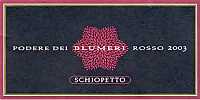
|
|
Blumeri Rosso 2003 |
|
| Schiopetto (Friuli Venezia Giulia, Italy) | |
| Grapes: Merlot (70%), Refosco dal Peduncolo Rosso (25%), Cabernet Sauvignon (5%) | |
| Price: € 24.00 | Score: |
| Blumeri Rosso shows a deep ruby red color and nuances of ruby red, little transparency. The nose reveals intense, clean, pleasing, refined and elegant aromas that start with hints of black cherry, plum and black currant followed by aromas of violet, blackberry, vanilla, tobacco, coffee, chocolate, licorice, eucalyptus, pink pepper and mace. The mouth has good correspondence to the nose, a tannic attack and however balanced by alcohol, full body, intense flavors. The finish is persistent with flavors of black cherry, plum and black currant. A well made wine. Blumeri Rosso ages in cask and in barrique for about 15 months. | |
| Food Match: Game, Roasted meat, Stewed and braised meat, Hard cheese | |

|
|
Mario Schiopetto Bianco 2006 |
|
| Schiopetto (Friuli Venezia Giulia, Italy) | |
| Grapes: Chardonnay (50%), Tocai Friulano (50%) | |
| Price: € 24.00 | Score: |
| This wine shows a pale straw yellow color and nuances of greenish yellow, very transparent. The nose reveals intense, clean, pleasing, refined and elegant aromas which start with hints of peach, pear and banana followed by aromas of pineapple, citrus fruits, acacia, hawthorn, apple, broom, almond, honey, gooseberry, elder and hints of vanilla. The mouth has excellent correspondence to the nose, a crisp attack and however balanced by alcohol, good body, intense flavors, agreeable. The finish is very persistent with long flavors of apple, peach, banana and almond. A well made wine. Part of this wine ages in cask. | |
| Food Match: Pasta with fish, Roasted fish, Roasted white meat, Broiled fish | |
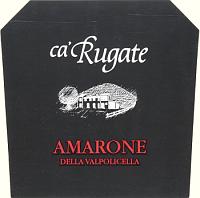
|
|
Amarone della Valpolicella 2004 |
|
| Ca' Rugate (Veneto, Italy) | |
| Grapes: Corvina (40%), Rondinella (30%), Corvinone (30%) | |
| Price: € 40.50 | Score: |
| This Amarone della Valpolicella shows a brilliant ruby red color and nuances of garnet red, moderate transparency. The nose denotes intense, clean, pleasing, refined and elegant aromas which start with hints of plum, blackberry and black cherry followed by aromas of violet, raspberry, vanilla, tobacco, pink pepper, chocolate, mace and menthol. The mouth has good correspondence to the nose, a tannic attack and however balanced by alcohol, full body, intense flavors. The finish is persistent with flavors of blackberry, black cherry and plum. A well made wine. Amarone della Valpolicella ages in cask for about 30 months. | |
| Food Match: Game, Roasted meat, Braised and stewed meat, Hard cheese | |
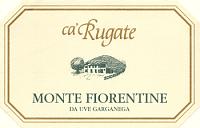
|
|
Soave Classico Monte Fiorentine 2006 |
|
| Ca' Rugate (Veneto, Italy) | |
| Grapes: Garganega | |
| Price: € 16.20 | Score: |
| Soave Classico Monte Fiorentine shows a pale straw yellow color and nuances of greenish yellow, very transparent. The nose reveals intense, clean, pleasing and refined aromas that start with hints of apple, grapefruit and plum followed by aromas of hawthorn, pineapple, almond, pear, elder, chamomile, tangerine and hints of mineral. The mouth has good correspondence to the nose, a crisp attack and however balanced by alcohol, good body, intense flavors, agreeable. The finish is persistent with flavors of apple, plum, pineapple and almond. A well made wine. Soave Classico Monte Fiorentine ages in steel tanks. | |
| Food Match: Fried fish, Pasta and risotto with fish and vegetables, Sauteed fish and crustaceans | |
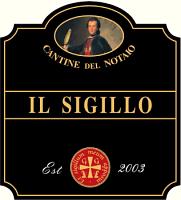
|
|
Aglianico del Vulture Il Sigillo 2003 |
|
| Cantine del Notaio (Basilicata, Italy) | |
| Grapes: Aglianico | |
| Price: € 36.00 | Score: |
| Aglianico del Vulture Il Sigillo shows an intense ruby red color and nuances of garnet red, little transparency. The nose denotes intense, clean, pleasing, refined and elegant aromas which start with hints of blackberry, plum and black cherry followed by aromas of violet, blueberry, vanilla, tobacco, chocolate, cinnamon, pink pepper, mace and menthol. The mouth has good correspondence to the nose, a tannic attack and however balanced by alcohol, full body, intense flavors, agreeable roundness. The finish is persistent with flavors of blackberry, plum and black cherry. A well made wine. Aglianico del Vulture Il Sigillo ages for 24 months in barrique. | |
| Food Match: Game, Stewed and braised meat, Roasted meat, Hard cheese | |

|
|
L'Autentica 2005 |
|
| Cantine del Notaio (Basilicata, Italy) | |
| Grapes: Moscato Bianco (70%), Malvasia Bianca (30%) | |
| Price: € 29.00 - 500ml | Score: |
| L'Autentica shows a brilliant amber yellow color and nuances of amber yellow, transparent. The nose reveals intense, clean, pleasing, refined and elegant aromas which start with hints of raisin, lychee and dried apricot followed by aromas of ripe banana, lavender, candied fruits, date, apple, pear, orange marmalade, honey, almond and vanilla. The mouth has excellent correspondence to the nose, a sweet attack and pleasing roundness, however balanced by alcohol, good body, intense flavors, agreeable crispness. The finish is very persistent with long flavors of raisin, lychee, dried apricot and almond. A well made wine. L'Autentica ferments and ages for 14 months in cask followed by 4 months of aging in bottle. | |
| Food Match: Hard and piquant cheese, Fruit tarts, Confectionery | |
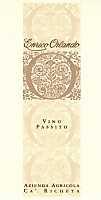
|
|
Vino Passito 2003 |
|
| Ca' Richeta (Piedmont, Italy) | |
| Grapes: Moscato Bianco, Sauvignon Blanc, Sémillon | |
| Price: € 20.00 - 375ml | Score: |
| This wine shows a brilliant amber yellow color and nuances of amber yellow, transparent. The nose reveals intense, clean, pleasing, refined and elegant aromas that start with hints of raisin, dried fig and almond followed by aromas of caramel, ripe banana, quince jam, candied fruits, licorice, honey, citrus fruit peel and vanilla. The mouth has good correspondence to the nose, a sweet and smooth attack, however balanced by alcohol, good body, intense flavors, agreeable. The finish is persistent with flavors of raisin, dried fig and licorice. A well made wine. This sweet wine ages for about 24 months in cask. | |
| Food Match: Hard and piquant cheese, Dried fruit desserts | |
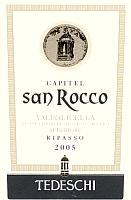
|
|
Valpolicella Superiore Ripasso Capitel San Rocco 2005 |
|
| Tedeschi (Veneto, Italy) | |
| Grapes: Corvina (30%), Corvinone (30%), Rondinella (30%), Molinara, Rossignola, Oseleta, Negrara, Dindarella (10%) | |
| Price: € 12.00 | Score: |
| Valpolicella Superiore Ripasso Capitel San Rocco shows an intense ruby red color and nuances of garnet red, moderate transparency. The nose reveals intense, clean, pleasing and refined aromas that start with hints of black cherry, blackberry and plum followed by aromas of blueberry, violet, vanilla, tobacco, licorice, cocoa and menthol. The mouth has good correspondence to the nose, a tannic attack and however balanced by alcohol, good body, intense flavors. The finish is persistent with flavors of blackberry, black cherry and plum. Valpolicella Superiore Ripasso Capitel San Rocco ages in cask for 2 years followed by 6 months of aging in bottle. | |
| Food Match: Roasted meat, Braised and stewed meat with mushrooms, Hard cheese | |
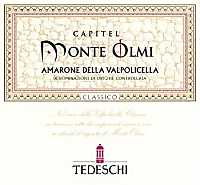
|
|
Amarone della Valpolicella Classico Capitel Monte Olmi 2003 |
|
| Tedeschi (Veneto, Italy) | |
| Grapes: Corvina (30%), Corvinone (30%), Rondinella (30%), Molinara, Rossignola, Oseleta, Negrara, Dindarella, Croatina, Forselina (10%) | |
| Price: € 47.50 | Score: |
| Amarone della Valpolicella Classico Capitel Monte Olmi shows a deep ruby red color and nuances of ruby red, little transparency. The nose reveals intense, clean, pleasing, refined and elegant aromas that start with hints of plum, blackberry and black cherry followed by aromas of violet, blueberry, tobacco, vanilla, chocolate, licorice, cinnamon, pink pepper, mace and menthol. The mouth has good correspondence to the nose, a tannic attack and however balanced by alcohol, full body, intense flavors, agreeable roundness. The finish is persistent with flavors of plum, blackberry and black cherry. A well made wine. Amarone della Valpolicella Classico Capitel Monte Olmi ages for about 3 years in cask followed by 6 months of aging in bottle. | |
| Food Match: Game, Braised and stewed meat, Roasted meat, Hard cheese | |
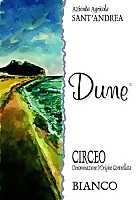
|
|
Circeo Bianco Dune 2005 |
|
| Sant'Andrea (Latium, Italy) | |
| Grapes: Malvasia Puntinata (40%), Trebbiano Toscano (60%) | |
| Price: € 8.00 | Score: |
| This wine shows an intense golden yellow color and nuances of golden yellow, very transparent. The nose reveals intense, clean, pleasing and refined aromas which start with hints of apple, pineapple and citrus fruits followed by aromas of hawthorn, chamomile, ripe peach, pear and medlar. The mouth has good correspondence to the nose, a crisp attack and however balanced by alcohol, good body, intense flavors, agreeable. The finish is persistent with flavors of apple, plum and pineapple. Circeo Bianco Dune ages in barrique for 6 months followed by 3 months of aging in bottle. | |
| Food Match: Pasta and risotto with fish and crustaceans, Sauteed white meat, Mushroom soups, Broiled fish | |
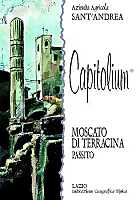
|
|
Capitolum 2005 |
|
| Sant'Andrea (Latium, Italy) | |
| Grapes: Moscato di Terracina | |
| Price: € 11.00 - 500ml | Score: |
| Capitolum shows a brilliant amber yellow color and nuances of amber yellow, transparent. The nose denotes intense, clean, pleasing and refined aromas that start with hints of raisin, dried apricot and dried fig followed by aromas of candied fruits, date, peach jam, lychee, almond, honey and citrus fruit peel. The mouth has good correspondence to the nose, a sweet attack and pleasing roundness, however balanced by alcohol, good body, intense flavors. The finish is persistent with flavors of raisin, dried apricot and dried fig. A small part of Capitolum ages in cask for 6 months. | |
| Food Match: Dried fruit desserts, Hard cheese | |
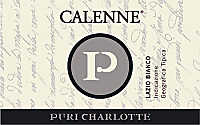
|
|
Calenne 2006 |
|
| Charlotte Puri (Latium, Italy) | |
| Grapes: Procanico (60%), Chardonnay (20%), Rossetto (15%), Sauvignon Blanc (5%) | |
| Price: € 10.00 | Score: |
| Calenne shows a brilliant straw yellow color and nuances of greenish yellow, very transparent. The nose reveals intense, clean, pleasing and refined aromas which start with hints of apple, pineapple and plum followed by aromas of jasmine, hawthorn, grapefruit, pear and hints of mineral. The mouth has good correspondence to the nose, a crisp attack and however balanced by alcohol, good body, intense flavors, agreeable. The finish is persistent with flavors of apple, plum and pineapple. Calenne ages in steel tanks. | |
| Food Match: Fried fish, Pasta and risotto with fish and vegetables, Sauteed fish | |
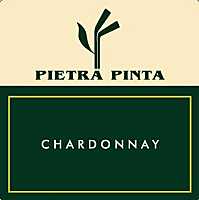
|
|
Chardonnay 2006 |
|
| Pietra Pinta (Latium, Italy) | |
| Grapes: Chardonnay | |
| Price: € 6.50 | Score: |
| This Chardonnay shows an intense golden yellow color and nuances of straw yellow, very transparent. The nose denotes intense, clean and pleasing aromas which start with hints of apple, plum and hawthorn followed by aromas of banana, pineapple and broom. The mouth has good correspondence to the nose, a crisp attack and however balanced by alcohol, good body, intense flavors. The finish is pretty persistent with flavors of apple and plum. Part of this wine ages in barrique. | |
| Food Match: Pasta and risotto with fish and vegetables, Broiled crustaceans, Sauteed meat | |
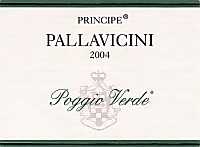
|
|
Frascati Superiore Poggio Verde 2006 |
|
| Principe Pallavicini (Latium, Italy) | |
| Grapes: Malvasia di Candia (50%), Malvasia del Lazio (20%), Trebbiano Toscano (10%), Greco, Grechetto (20%) | |
| Price: € 7.50 | Score: |
| This Frascati shows an intense greenish yellow color and nuances of greenish yellow, very transparent. The nose denotes intense, clean and pleasing aromas that start with hints of apple, citrus fruits and almond followed by aromas of pineapple, hawthorn and broom. The mouth has good correspondence to the nose, a crisp attack and however balanced by alcohol, good body, intense flavors. The finish is pretty persistent with flavors of apple and citrus fruits. Frascati Superiore Poggio Verde ages in steel tanks. | |
| Food Match: Dairy products, Crustacean appetizers, Risotto with fish and vegetables | |
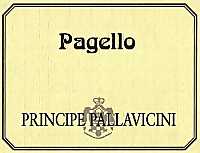
|
|
Pagello 2006 |
|
| Principe Pallavicini (Latium, Italy) | |
| Grapes: Greco Bianco (50%), Grechetto (50%) | |
| Price: € 8.00 | Score: |
| Pagello shows a pale straw yellow color and nuances of greenish yellow, very transparent. The nose denotes intense, clean and pleasing aromas that start with hints of apple, plum and anise followed by aromas of hazelnut, hawthorn and pear. The mouth has good correspondence to the nose, a crisp attack and however balanced by alcohol, good body, intense flavors. The finish is persistent with flavors of apple and plum. Pagello partially ferments in barrique. | |
| Food Match: Fish and crustacean appetizers, Pasta and risotto with fish and vegetables | |
News |
|
In this section are published news and information about events concerning the world of wine and food. Whoever is interested in publishing this kind of information can send us a mail to our address.
|
SesameReserved and discrete, with a full and charming taste, sesame is among the most ancient condiments known by men, used for the preparation of foods since 3000 BC |
|
Sesame “Sesamum Indicum” is a flowering plant belonging to the family of Pedaliaceae, originating from India and Africa, presently cultivated in many regions of the world, from China to the United States. It is an annual plant, having an erect stalk of about 80 centimeters long, but in some regions, with a particularly favorable climate, it can also reach 3 meters. Leaves are opposed and with an elongated shape, flowers have a calyx with five tips, cylindrical corolla and five petals of white or rose color with black spots. Pollination is autogamous consisting in the transportation of the pollen from anthers to the pistils of the same flower, from which are generated elongated capsules two centimeters long, containing many seeds (from 50 to 100) of flat aspect and with a pointed tip, about one or two millimeters long. Sesame is a plant which cannot stand the cold - it does not stand to temperatures lower than 10° C - it can survive well also in conditions of drought, however in case it is being regularly irrigated, it has a higher production. As for the soil, sesame does not have particular needs, however as it is a plant with a rapid growth, it needs a soil rich in nutritional substances and easily assimilable.
There are many varieties of sesame, they are classified according to the color of the seeds: white, black and yellow. Seeds are the part of the plant to be used, they are rich in mineral salts, vitamin E, calcium, proteins and many natural oils. Seeds are harvested and allowed to dry under the sun for about 10 days, therefore they can be consumed, or can be processed in order to extract an oil with a sweetish taste and used in cooking. It is believed sesame has been one of the first plants to be cultivated and it was probably one of the first plants to be used as a food or condiment. This hypothesis is supported by the examination of some Sumerian clay tablets dated back to 2300 BC. Babylonians used sesame - since 2200 BC - for the preparation of sweets, to make an alcoholic beverage and they knew the technique of the extraction of the oil from its seeds. Egyptians knew sesame seeds and they mainly used them in pharmaceutical preparations. In the Nile valley, in 1875 was found some papyri, dated back to 3000 BC, in which it is mentioned sesame and the way it was used in pharmaceutical preparations, moreover, evident proofs of sesame were found in pyramids dated back to 2700 BC. From some archaeological findings was discovered that, still in the same period, sesame plant was very common in the Syrian and Palestinian areas. In those areas was used sesame oil as a fuel for lamps. In Sri Lanka, Indonesia and in the Indochinese area, missionary Buddhist monks have contributed to the spreading and culture of sesame. The use of sesame in the Indian area is dated back to the third century BC: this can be found out by the findings from the archaeological site of Harappa, located in the eastern banks of Ravi river, where are found the remaining of the two important Indian cities of Harappa and Mohenjo-daro. Examination done with radiocarbon have dated these two cities to a period from 2300 BC and 1750 BC. In these places was also found a handful of carbonized sesame seeds. Indians believe sesame was originated in remote times, a gift given by gods: according to Indian literature sesame seeds were originated from Vishnu's sweat drops. Information of the usage of sesame seed are found in the most ancient and important Indian books, such as Rgveda, Atharvaveda and Yajurveda. In Manavadharmasastra was illustrated the way of using sesame in the many aspects of life, religion, family and medicine. In Indian culture there are strict rules about the respect to be paid to a plant of sesame: a peasant can sell the seeds of the plant, but they must be used for religious purposes only. In Indian religious culture, sesame seeds are strictly connected to conception and to procreation, therefore they are the symbol of rebirth, for this reason they were used in rituals for ancestors, to whom it could open the doors of heaven and to get the favor of Yama, god of the dead. Another power of sesame seed, which connected it to the world of the living and the dead, was to clean every sin. The importance of sesame in the culture of Indian area, was also shown by the fact in sacred Buddhist books sesame was mentioned among superior foods, widely used in the diet of monks. Buddha suggested sesame seed, although it was very small, it could generate a big tree. Another method of using sesame seeds was, as suggested by the Atharvaveda, the extraction of the oil, which was also used in Hindu funeral ceremonies to purify the corpse and the stake. Sesame oil was also used during the obsequies of Buddha: it is in fact told monks put the corpse of the Buddha in an ark full of sesame oil. Sesame also plays an important role in traditional medicine. According to famous medicine books Characa Samhita (second century BC) and Susruta (sixth century BC), sesame oil was a good remedy against burns, to prepare remedies for convulsions, headache, earache and tetanus. According to traditional medicine, sesame seeds and their preparations, were effective also thanks to its magical properties for being a divine plant, and could chase off demons causing diseases. Sesame seeds were spread on the seats of guests in order to chase off demons which could have disturbed them.
|
||||||||
|
Sesame oil is generally found in every cooking oil and in margarine, in variable quantity of about 5%. In Asian regions sesame oil is used to dress foods and it is added to rice. Moreover sesame oil is used by cosmetic industry and pharmacological industry. Tahin or Tahini (pronounced as tahineh), is a cream obtained by crushing sesame seeds, slightly toasted, and mixed with oil, in order to get the consistency of a thick cream, also known as sesame butter or sesame cream. Used in Middle Eastern and Greek cooking, it is very common in Turkey. Halva or Helva, is a sweet made from Tahin mixed with sugar and other flavorings, very common in the East. Gomashio, which is obtained from toasted sesame seed and salt, is typical in Japanese and Korean cooking. The best way to use sesame seeds is to ground them at the moment of consumption and to use them as soon as possible, as they contain some fatty acids, belonging to the family of Omega-3, which get easily spoiled in contact with the air and with an excessive heat. Sesame seeds can be used to season salads, sauteed vegetables, meatballs and home made bread. Sesame seeds are used for the preparation of gomashio (from Japanese goma, sesame seeds, and shio, salt), known in Korea as Ggaessogum. It is a compound of salt and toasted and crushed sesame seeds, to which are sometimes added seaweeds, used in Asian cooking as a condiment for sauces and salads. In Egypt sesame is added to spices, salt, hazelnuts and olive oil to make Dukka or Dukkah. There are three varieties of sesame: white, black and yellow. White and yellow sesame are basically the same and are considered to be best for cooking, whereas black sesame is considered the best for the preparation of pharmaceutical products. In the East it is said black sesame, added to a daily diet, has the property of giving the hair a deep black color. Sesame is an excellent tonic in general, it is used as a food supplement for the diet of kids in case of growth lower than the norm. Sesame seeds, thanks to their chemical composition, are a small concentrate of vitamins and minerals. A teaspoon of sesame oil a day helps to keep the skin young and it is effective for the good functionality of the bowel. More of the 25% in sesame seeds is made from high quality proteins. It is also rich in calcium and zinc, it is good against infections, to contrast the action of free radicals, very useful during growth and for the ones doing an intellectual job. Sesame seeds are rich in unsaturated fats Omega-3 and Omega-6, useful for the protection of the body against circulatory diseases. Sesame is a good source of calcium, useful for people over 60 and for osteoporosis, during pregnancy and breast feeding, for anyone doing sport and for anyone having a sedentary life. Sesame contains a quantity of calcium equal to the one of cheese and does not contain any cholesterol, triglycerides and saturated fats. It can be consumed by subjects suffering from milk allergies and strengthens the immunitary system in convalescing subjects. Sesame seeds can be kept in paper or fabric bags and stored in a dry place. Because of its high contents in fats, sesame can easily go rancid, therefore it is always advised to buy and use it fresh.
|
AquavitaeReview of Grappa, Distillates and Brandy |
|
|
| Distillates are rated according to DiWineTaste's evaluation method. Please see score legend in the "Wines of the Month" section. |

|
|
Grappa di Recioto di Soave |
|
| Ca' Rugate (Veneto, Italy) | |
| (Distiller: Distilleria Maschio Pietro) | |
| Raw matter: Pomace of Garganega | |
| Price: € 20,00 - 50cl | Score: |
| This grappa is limpid, colorless and crystalline. The nose denotes intense, clean and pleasing aromas of almond, apple, pear, honey and plum, with almost imperceptible alcohol pungency. In the mouth has intense flavors, with perceptible alcohol pungency which tends to dissolve rapidly, good correspondence to the nose, balanced sweetness, pleasing roundness. The finish is persistent with flavors of apple, plum and honey. This grappa is distilled with a discontinuous steam operated alembic still. Alcohol 43%. | |

|
|
Grappa di Amarone |
|
| Ca' Rugate (Veneto, Italy) | |
| (Distiller: Distilleria Maschio Pietro) | |
| Raw matter: Pomace of Corvina, Corvinone, Rondinella | |
| Price: € 20,00 - 50cl | Score: |
| This grappa shows a light straw yellow color, limpid and crystalline. The nose reveals intense, clean, pleasing and refined aromas of vanilla, tobacco, honey, plum, licorice, hazelnut, praline and blackberry, with almost imperceptible alcohol pungency. In the mouth has intense flavors, with perceptible alcohol pungency which tends to dissolve rapidly, good correspondence to the nose, balanced sweetness, pleasing roundness. The finish is persistent with flavors of hazelnut, plum, honey and licorice. This grappa is distilled with a discontinuous steam operated alembic still and ages in cask for about 6-9 months. Alcohol 43%. | |
Wine Parade |
|
|
| The best 15 wines according to DiWineTaste's readers. To express your best three wines send us an E-mail or fill in the form available at our WEB site. |
| Rank | Wine, Producer | |
|---|---|---|
| 1 |
| Sforzato di Valtellina Canua 2001, Conti Sertoli Salis (Italy) |
| 2 |
| Barolo Cannubi Boschis 2001, Sandrone (Italy) |
| 3 |
| Amarone della Valpolicella Classico 2000, Zenato (Italy) |
| 4 |
| Soave Classico Monte Alto 2004, Ca' Rugate (Italy) |
| 5 |
| Barolo Bussia 2001, Prunotto (Italy) |
| 6 |
| Sagrantino di Montefalco Collepiano 2003, Arnaldo Caprai (Italy) |
| 7 |
| Collio Bianco Col Disôre 2004, Russiz Superiore (Italy) |
| 8 |
| Amarone della Valpolicella Classico Costasera 2001, Masi (Italy) |
| 9 |
| San Leonardo 2001, Tenuta San Leonardo (Italy) |
| 10 |
| Don Antonio 2003, Morgante (Italy) |
| 11 |
| Bradisismo 2003, Inama (Italy) |
| 12 |
| Nero al Tondo 2001, Ruffino (Italy) |
| 13 |
| Wine Obsession 2001, Vignamaggio (Italy) |
| 14 |
| Mater Matuta 2003, Casale del Giglio (Italy) |
| 15 |
| Chianti Classico Riserva Novecento 2000, Dievole (Italy) |
| |||||||
Privacy Policy | |||||||


| Copyright © 2002-2024 Antonello Biancalana, DiWineTaste - All rights reserved |
| All rights reserved under international copyright conventions. No part of this publication and of this WEB site may be
reproduced or utilized in any form or by any means, electronic or mechanical, without permission in writing from DiWineTaste. |